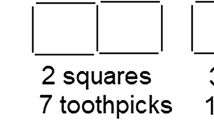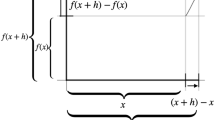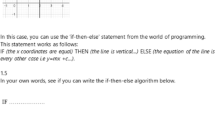Abstract
The Mathematics education community has long recognized the importance of diagrams in the solution of mathematical problems. Particularly, it is stated that diagrams facilitate the solution of mathematical problems because they represent problems’ structure and information (Novick & Hurley, 2001; Diezmann, 2005). Novick and Hurley were the first to introduce three well-defined types of diagrams, that is, network, hierarchy, and matrix, which represent different problematic situations. In the present study, we investigated the effects of these types of diagrams in non-routine mathematical problem solving by contrasting students’ abilities to solve problems with and without the presence of diagrams. Structural equation modeling affirmed the existence of two first-order factors indicating the differential effects of the problems’ representation, i.e., text with diagrams and without diagrams, and a second-order factor representing general non-routine problem solving ability in mathematics. Implicative analysis showed the influence of the presence of diagrams in the problems’ hierarchical ordering. Furthermore, results provided support for other studies (e.g. Diezman & English, 2001) which documented some students’ difficulties to use diagrams efficiently for the solution of problems. We discuss the findings and provide suggestions for the efficient use of diagrams in the problem solving situation.















Similar content being viewed by others
References
Bentler, P. M. (1995). EQS structural equations program manual. Encino: Multivariate Software.
Bishop, A. J. (1980). Spatial abilities and mathematics education: a review. Educational Studies in Mathematics, 11(3), 257–269. doi:10.1007/BF00697739.
Booth, R., & Thomas, M. (2000). Visualization in mathematics learning: arithmetic problem-solving and student difficulties. The Journal of Mathematical Behavior, 18(2), 169–190. doi:10.1016/S0732-3123(99)00027-9.
Cheng, P. C. H. (2002). Electrifying diagrams for learning: principles for complex representational systems. Cognitive Science, 26, 685–736.
Cox, R. (1999). Representation construction, externalized cognition and individual differences. Learning and Instruction, 9, 343–363. doi:10.1016/S0959-4752(98)00051-6.
Demetriou, A., Efklides, A., & Platsidou, M. (1993). The architecture and dynamics of developing mind: experiential structuralism as a frame for unifying cognitive developmental theories. Monographs of the Society for Research in Child Development, 58, 5, 6 Serial No. 234.
Diezmann, C. (2005). Assessing primary students’ knowledge of networks, hierarchies and matrices using scenario-based tasks. In P. Clarkson, A. Downtown, D. Gronn, M. Horne, A. McDonagh, R. Pierce, & A. Roche (Eds.), Proceedings of the 28th Annual Conference of the Mathematics Education Reseach Group of Australasia (pp. 289–296). Sydney: MERGA.
Diezmann, C. (2006). Primary students’ reasoning about diagrams: The building blocks of matrix knowledge. In J. Novotna, H. Moraova, M. Kratka, & N. Stehlikova (Eds.), Proceedings of the 30th Conference of the International Group for the Psychology of Mathematics Education. Vol. 2 (pp. 433–440). Prague: PME.
Diezmann, C., & English, L. (2001). Promoting the use of diagrams as tools for thinking. In A. Cuoco, & F. Curcio (Eds.), The roles of representation in school mathematics: 2001 YearBook (pp. 1–23). Virginia: NCTM.
Dufour-Janvier, B., Bednarz, N., & Belanger, M. (1987). Pedagogical considerations concerning the problem of representation. In C. Janvier (Ed.), Problems of representation in the teaching and learning of mathematics (pp. 110–120). Hillsdale: Erlbaum.
Duval, R. (2006). A cognitive analysis of problems of comprehension in learning of mathematics. Educational Studies in Mathematics, 61, 103–131. doi:10.1007/s10649-006-0400-z.
Eisenberg, T., & Dreyfus, T. (1991). On the reluctance to visualize in mathematics. In W. Zimmermann, & S. Cunningham (Eds.), Visualization in teaching and learning of mathematics (pp. 25–37). Washington: Mathematical Association of America.
Elia, I., & Philippou, G. (2004). The functions of pictures in problem solving. In M. Johnsen Hoines, & A. Berit Fuglestad (Eds.), Proceedings of the 28th Conference of the International Group for the Psychology of Mathematics Education: Vol. 2 (pp. 327–334). Bergen: PME.
Elia, I., & Gagatsis, A. (2008). A comparison between the hierarchical clustering of variables, implicative statistical analysis and confirmatory factor analysis. In R. Gras, E. Suzuki, F. Guillet, & F. Spagnolo (Eds.), Studies in computational intelligence127: Statistical implicative analysis (pp. 131–163). Heidelberg: Springer.
Elia, I., Gagatsis, A., & Demetriou, A. (2007). The effects of different modes of representation on the solution of one-step additive problems. Learning and Instruction, 17, 658–672. doi:10.1016/j.learninstruc.2007.09.011.
English, L. (1996). Children’s construction of mathematical knowledge in solving novel isomorphic problems in concrete and written form. The Journal of Mathematical Behavior, 15, 81–112. doi:10.1016/S0732-3123(96)90042-5.
Gagatsis, A., & Elia, E. (2004). The effects of different modes of representation on mathematical problem solving. In M. J. Hoines, & A. B. Fuglestad (Eds.), Proceedings of the 28th Conference of the International Group of the Psychology of Mathematics Education. Vol. 2 (pp. 447–454). Bergen: PME.
Gras, R., Suzuki, E., Guillet, F., & Spagnolo, F. (2008). Studies in computational intelligence127: Statistical Implicative Analysis. Heidelberg: Springer.
Hembree, R. (1992). Experiments and relational studies in problem solving-a metaanalysis. Journal for Research in Mathematics Education, 23, 242–273. doi:10.2307/749120.
Hittleman, D. R. (1985). A picture is worth a thousand words...if you know the words. Childhood Education, 62, 32–36.
Hu, L., & Bentler, P. M. (1999). Cut off criteria for fit indexes in covariance structure analysis: Conventional criteria versus new alternatives. Structural Equation Modeling, 6, 1–55.
Kaizer, C., & Shore, B. (1995). Strategy flexibility in more and less competent students on mathematical word problems. Creativity Research Journal, 8(1), 77–82. doi:10.1207/s15326934crj0801_6.
Kidman, G. (2002). The accuracy of mathematical diagrams in curriculum materials. In A. Cockburn, & E. Nardi (Eds.), Proceedings of the 26th Conference of the International Group of the Psychology of Mathematics Education. Vol. 3 (pp. 201–208). London: PME.
National Council of Teachers of Mathematics (2000). Principles and standards for school mathematics. Reston: NCTM.
Novick, L. (1988). Analogical transfer, problem similarity, and expertise. Journal of Experimental Psychology. Learning, Memory, and Cognition, 14, 510–520. doi:10.1037/0278-7393.14.3.510.
Novick, L. R. (2006). Understanding spatial diagram structure. Quarterly Journal of Experimental Psychology, 59, 1826–1856. doi:10.1080/17470210500298997.
Novick, L., & Hurley, M. (2001). To matrix, network, or hierarchy: that is the question. Cognitive Psychology, 42, 158–216. doi:10.1006/cogp.2000.0746.
Pólya, G. (1945). How to solve it. Princeton: Princeton University Press.
Presmeg, N. C. (2006). Research on visualization in learning and teaching mathematics. In A. Gutiérrez, & P. Boero (Eds.), Handbook of research on the psychology of mathematics education: Past, present and future (pp. 205–235). Rotterdam: Sense.
Robinson, H., & Schraw, G. (1994). Computation efficiency through visual argument: do graphic organizers communicate relations in text too effectively? Contemporary Educational Psychology, 19, 339–415. doi:10.1006/ceps.1994.1029.
Schnotz, W. (2002). Towards an integrated view of learning from text and visual displays. Educational Psychology Review, 14(1), 101–120. doi:10.1023/A:1013136727916.
Schoenfeld, A. (1985). Mathematical problem solving. New York: Academic.
Schoenfeld, A. (1992). Learning to think mathematically: Problem-solving, metacognition, and sense making in mathematics. In D. A. Grouws (Ed.), Handbook of research on mathematics teaching and learning (pp. 334–368). New York: Macmillan.
Stern, E., Aprea, C., & Ebner, H. G. (2003). Improving cross-content transfer in text processing by means of active graphical representation. Learning and Instruction, 13, 191–203. doi:10.1016/S0959-4752(02)00020-8.
Stylianou, D. A. (2001). On the reluctance to visualize in mathematics. Is the picture changing? In M. Van den Heuven-Panhuizen (Ed.), Proceedings of the 25th Conference of the International Group of the Psychology of Mathematics Education. Vol. 4 (pp. 225–232). Netherlands: PME.
Stylianou, D. A., & Dubinsky, E. (1999). Determining linearity: The use of visual imagery in problem solving. In F. Hitt, & M. Santos (Eds.), Proceedings of the Twenty-first Annual Meeting of the North American Chapter of the International Group for the Psychology of Mathematics Education -(PME-NA) (pp. 245–252). Columbus: ERIC/CSMEE.
Theodoulou, R., Gagatsis, A., & Theodoulou, A. (2004). Un’immagine vale più di mille parole...Ma che tipo di immagine risulta più efficace nelle attività di problem solving matematico degli studenti? (A picture is worth more than a thousand words... But what type of pictures is more effective in students’ activity of problem solving?). La matematica e la sua didattica, 2, 4–32.
Uesaka, Y., Manalo, E., & Ichikawa, S. (2007). What kinds of perceptions and daily learning behaviors promote students’ use of diagrams in mathematics problem solving? Learning and Instruction, 17, 322–335. doi:10.1016/j.learninstruc.2007.02.006.
Vekiri, I. (2002). What is the value of graphical displays in learning? Educational Psychology Review, 14(3), 261–312. doi:10.1023/A:1016064429161.
Zhang, J. (1997). The nature of external representations in problem solving. Cognitive Science, 21(2), 179–217.
Zhang, J., & Norman, D. A. (1994). Representations in distributed cognitive tasks. Cognitive Science, 8, 87–122.
Acknowledgment
The authors are grateful to the Editor and three anonymous reviewers for their comments on an earlier version of this paper.
Author information
Authors and Affiliations
Corresponding author
Appendix
Appendix
1.1 Test B
-
1.
A man planted four trees in a straight path.
-
The tree A was first in the row while the tree B was last in the row.
-
The distance between tree A and tree B was 25 m.
-
The distance between tree A and tree C was 15 m.
-
The distance between tree D and tree B was 15 m.
Find the distance between tree D and tree A.

-
-
2.
Mr. Andreas is standing in a rung of a ladder and cleans the building’s windows. Then, he stepped up three rungs to clean the rest of the windows. Next, he went down five rungs to clean other windows. Then he climbed up seven rungs to clean the rest of the windows and he was at the ninth rung of the ladder.
In which rung did Mr. Andreas stand when he first started cleaning the windows?

-
3.
A card company plans to make new boxes of greeting cards. In each box, there will be greeting cards that are:
-
Either green or yellow and have
-
Either Christmas greetings or Easter greetings and have
-
Either gold ribbon or silver ribbon.
How many different cards will the company make?

-
-
4.
Four teams competed in a knockout volleyball competition. Team A beat Team B and Team C lost to Team D. Who was the winner if Team D lost the final game?

-
5.
Four friends, Anna, Vasos, Costas, and Dina like different kind of books. One likes comedies, one likes mysteries, one likes drama, and one likes adventures. Use the clues to help you find out which book each friend likes.
-
One of Anna’s friends likes mystery books.
-
Costas and Dina are not interested in adventure books.
-
Vasos likes drama books.
-
Dina does not like comedy books.

-
-
6.
John sells ice cream. He sells three different types of cones, a white, a brown and a yellow one. He sells four different flavors, strawberry, chocolate, vanilla, and hazelnut. How many different combinations of cones and flavors can John do?

Rights and permissions
About this article
Cite this article
Pantziara, M., Gagatsis, A. & Elia, I. Using diagrams as tools for the solution of non-routine mathematical problems. Educ Stud Math 72, 39–60 (2009). https://doi.org/10.1007/s10649-009-9181-5
Received:
Accepted:
Published:
Issue Date:
DOI: https://doi.org/10.1007/s10649-009-9181-5









